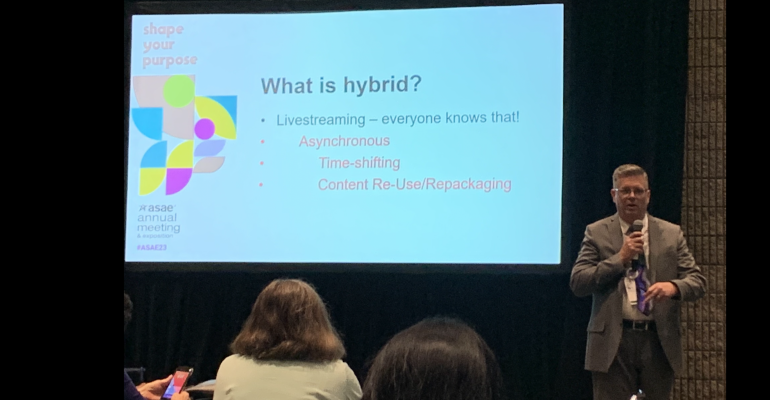In the post-Covid era, many associations are dead set on building back their in-person annual meetings not to simply match their pre-Covid editions, but to surpass them. To go all in, one option for associations is to abandon the online edition of the meeting and focus exclusively on the physical event.
This was an interesting topic at the American Society of Association Executives’ Annual Meeting & Exposition, held in Atlanta in August. Why? Because ASAE did not host a virtual audience for this event; in fact, it didn’t even record sessions for later viewing.
Michelle Mason, FASAE, CAE, president and CEO of ASAE, said in the event’s press conference that the decision reflected ASAE leadership’s desire to have the planning and production teams fully focused on delivering an in-person experience that made a deep enough impact on members, many of whom had not seen each other in three years, that they would choose to return in future years.
ASAE is hardly alone in taking that approach. During the breakout session, Mary Pat Cornett, CAE, CMP, chief strategy and operations officer for the American Society for Nutrition, noted that her group is also sticking exclusively with in-person meetings for the foreseeable future. “We went from 3,000 in-person attendees [in 2019] to 30,000 virtual ones [in 2022], but we did not do a virtual edition in 2023,” she said. “We chose to put all our effort into making this year’s event worth traveling to. We did record some sessions for later viewing but did not put big resources into that when we really had to maximize the return on the in-person experience. Besides, not enough of our members were interested in the hybrid format” to invest in that effort.
The Hybrid Option
Barry Schieferstein, CMP, DES, director of events for the American Society for Nondestructive Testing, said that his group went to an asynchronous hybrid format starting in 2021 and will continue with that approach. It is conducted in two ways: First, selected sessions are presented a second time before a camera by the in-person speaker, in a style more conducive to an online audience. Second, other in-person sessions are recorded and then replayed for the online audience, but with the presenter moderating the chat forum to provide live interaction.
“At this point, online audiences no longer expect the same level of interaction and networking as in person,” Schieferstein noted. With the virtual version, “we are giving our members enough of a taste of the in-person edition to make them want to attend next year.”
Bill Reed, chief event strategy officer for the American Society of Hematology, said that with his group’s asynchronous hybrid event, “we have not experienced any cannibalizing of our in-person attendance. Of our 5,000 virtual attendees, almost none would come to the in-person edition” because they are located outside of the United States. His goal with the virtual version, then, is to raise the awareness and reputation of the association around the world, which will draw more attendees both in person and online over time.
In addition, ASH’s uses the sessions recorded at the in-person event as the basis for subscriptions of different lengths that provide access to the content. Virtual and in-person attendees have free access to all sessions posted online for 30 days after the event, but ASH allows any member to purchase additional access month by month—which some attendees do along with non-attendees. “This brings us a good amount of additional revenue at no additional cost,” he noted.
The good news is that associations have time to conduct member surveys and then plan any revisions to how they build their annual meetings. In fact, “the door is still open in the future for synchronous hybrid events,” Cornett said. “Few associations need to decide right now what they are going to do three or four years from now.”





